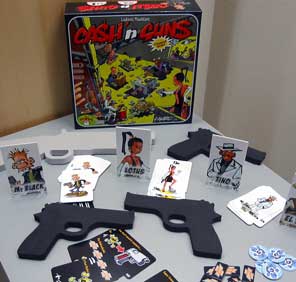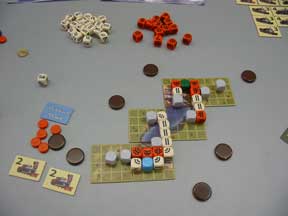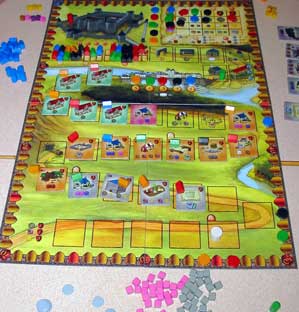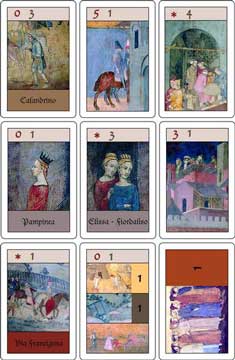Repos Production
Repos Production is a new (to me, anyway) Belgian outfit and their game is Cash ’n Guns. Think Reservoir Dogs. The players are robbers sharing out the loot from a job. The question is whether (and when) to shoot one of the others – so that they don’t get a share – or not. So, everybody plays a card and points their gun (a foam rubber silhouette) at their target. The targets have the opportunity to duck, which puts them out of the divvy-up. Then the cards are revealed to see who’s actually fired a shot (each player only has a few shots). This is just a very silly game that is huge fun! Add in special powers for each player and the option of including an undercover cop (which gets us to the Reservoir Dogs scenario) and this is a terrific game. My favourite silly game of Spiel ’05. Sagacity GamesAustralian publisher Sagacity Games had a new game from proprietor Don Bone. Freya’s Folly has its roots in Norse legend. The title refers to the Brisingamen, the necklace of amber and gold that Freya had wrought by the Dwarven smiths, paying them with her favours. In this game the players are those Dwarven smiths. Each player has a team of Dwarves, who dig precious gems from the mines (collect cubes of different colours from the board) and make jewellery from them (match sets of cubes to cards). Ordinary jewellery is worth points at the end of the game. Unless it’s incomplete, when the owner pays a penalty. (Taking a jewellery card to prevent someone else completing it is a useful tactic, but backfires if you can’t complete it.) As well as the ordinary gems and jewellery, players may collect pieces of amber and use them to complete sections of the Brisingamen. This brings the player rewards from Freya: tokens that can be traded in to take extra actions each turn. They are also worth points at the end of the game – and twice as much if the Brisingamen is complete. The game ends either when the Brisingamen is finished or if one player has made jewellery with all his Dwarves (they take the jewellery to market and don’t come back – probably because they’re in the pub). This makes the end of the game unpredictable. But, at the same time, something players can influence. This is a fascinating tactical game. Just moving your Dwarves through the mines is a little game in its own right. And players have to choose whether to go for the smaller, shallower stashes, make cheaper jewellery quickly and hope to end the game before the others notice. Or to go deep, pick up lots of gems and amber and either go for expensive jewellery or parts of the Brisingamen – should they appear. Much of the game is controlled by the appearance of cards, so you also have to ride your luck. An excellent, challenging game that only misses being one of my favourites at the show because I didn’t play it until I was back home. Schmidt SpieleStrangely we continue the theme of digging gems out of mines with Diamant by Alan Moon and Bruno Faidutti. Published by Schmidt, this is a fun game along Can’t Stop lines as players decide how far to push their luck – as mentioned in TWJO 54. Angkor was new to me, though. Designed by Knud Happel, this looks like another in the Tikal family. However, this is a game about building temples, not digging them up. Though the distinction may be moot as the players have to stop the jungle encroaching on their buildings during construction. The tactics of this don’t seem to be too deep. You play tiles onto the board or other tiles to expand your temple complex or diminish your opponents’. Worth a try. Sphinx SpieleverlagSphinx Spieleverlag is the vehicle for Henning Pöhl’s neat little games. This year we have Spinnentwist (Spidertwist), a two-player mating game. But not with each other. Each player has a team of male spiders that they are trying to manoeuvre towards the (larger) female spider in the middle of the web. However, each time a male spider moves, the female moves towards him. If she lands on a male spider, she just eats him (-1 point). The male spider has to land on the female to mate successfully (+2 points). Most points wins, of course. This is a neat little game, if a bit abstract for me. The board is double-sided, showing the web in winter (harder) and summer (easier). Well worth a look. Totentanz (Dance of the Dead) is a two-player card game. This looks terrific – the cards are double-sized and illustrated in an engraving style – but I didn’t get the chance to try the game. Splotter Spellen
Dutch publisher Splotter Spellen is well-known for its big, gamers’ games and this year’s title is no exception. The chunky box for Indonesia suggests it will take 3-4 hours to play. Inside is a large board, showing the islands and other territories of Indonesia. Despite being largely in shades of brown, this looks terrific. The game, designed by Joris Wiersinga and Jeroen Doumen, is about the economic development of the region – and the player’s businesses. As I expect from these guys, gameplay is complex as players establish plantations and markets and connect them with shipping. A must for anyone who likes big games – like me. However, I don’t know enough about the game to be able to say more than that. Yet. Sunriver GamesSunriver is a new US publisher and they have one game: Havoc: the Hundred Years War. This is a bidding card game with some interesting features. Havoc is played over a series of battles (from the appropriate period, so Agincourt features) and players score points according to the best bid for each battle. Some battles will give points to first, second and third, for others it’s winner takes all. Players bid to win the battle by playing cards from their hand. Play goes round with players adding more cards to their bid (to a maximum of six) or dropping out. Once only one player is left in the bidding, the hands are evaluated. Hands are ranked Poker style. As a player may have six cards, there is some extension to this – six of a kind, two threes, three pairs and so on. Players discard all cards played and pick up the appropriate number of points. The next battle is now the focus of play. Players draft cards in turn to expand their hands until someone decides to start the fight. And there is a penalty if the battle doesn’t start quickly enough. Once all the battles have been resolved, the game is over and the player with the most points wins. Havoc isn't a very deep game, but there are some nice tactical ploys in the battles. Not to mention the ‘Dogs of War’. These cards are worth zero, but may be used after a battle to retrieve cards back into your hand. A good, solid little game. Tilsit EditionsSomehow I contrived to miss Tilsit, despite them being in Hall 12. They had a new edition of Emanuele Ornella’s Fantasy Pub, previously published by Mind the Move, and an expansion (up to six players) for Himalaya. Of more interest was Key Largo, originally devised by the late Paul “Pirate’s Cove” Randles and completed by Bruno Faidutti and Mike Selinker. This is a family game of deep sea divers searching for treasure in sunken wrecks. A kind of sequel to Pirate’s Cove. Worth a look. Tilsit also had Caramba! from Michael Schacht. The setting is early 20th century Mexico where the players compete to gather gold, guns and dynamite. This is a bidding and bluffing card game that also sounds worth a look. Tresham GamesVeteran designer Francis Tresham had his usual corner of the Mayfair Games stand to show the latest from Tresham Games. This was 1829 Mainline, which comes in a fetching powder blue box. As you can tell from the name, this is an 18xx game, which means a combination of railway-building and stock markets. Since Francis designed it, the emphasis is more on railway-building than manipulating stock. The board is a cunningly skewed map of (most of) the British mainland that allows London to be at one end and Glasgow at the other. The game is intended to encourage players to build big networks and run fast trains along long routes. This means some of the tactical details have been taken out. And, to mix things up, each player is dealt a hand of share certificates at the start. Initially, these are the only shares they can buy. This should make it rather different from other 18xx games and I look forward to trying it out. Van der Veer GamesThe name may sound Dutch, but Van der Veer come from Singapore. They had a set of four games on show at Spiel, all aimed at family play and all designed by Jacques Deul. Blackmail is a roll-the-dice-and-move-the-dobber board game. There is a twist in that you set up surveillance cameras to get the opportunity to ‘blackmail’ the other players. Hollywood Players is a card game in which players draw or ‘poach’ cards. The aim is to build up the best hand of Actor, Actress and Director and win awards. It seems simple stuff. Trading Routes is also a card game. Here players build up a map of jungle paths, ruins and tribal villages. The player whose route connects the most of these will win. The fourth game is Mob City. In this, the players are mobsters trying to take over the family as the new Don. It appears to be significantly more complex than Van der Veer’s other games and thus provides more of a challenge. Players have to build up a crew – but they cost money – and use this to take over businesses. And rub out their opponents. Not having played it, I don’t know the quality of the game, but it certainly sounds appealing. WarfrogWarfrog was in their usual position and several things for us. First up was expansion number four for Age of Steam: France/Italy. The two boards can be laid in a rectangle to give a map of France or in line (the other way up) for Italy. Additional rules for the two boards give them both a different flavour. And then there was the new Martin Wallace design, Byzantium. This puts the players in the position of the factions defending the last remnant of the Roman Empire – the city of Byzantium – from the barbarian hordes. At the same time, players also have control of some of the hostile forces – an opportunity to do down the other factions in Byzantium. This looks like another clever game and another that I’m looking forward to playing. 
Wassertal GamesWassertal had a revised version of Railroad Dice for us. Called Railroad Dice 2, the game has been modified sufficiently by designer Jens Kappe to make it a different game. I didn’t get to try it, but removing the stock market element makes for a faster, simpler game, focussed on railroad building. I rather liked the original, so I’ll have to be convinced this is better. Certainly worth trying, though. Winning MovesI managed to miss the Winning Moves stand this year – partly because I recoiled when I saw their Sudoku – the board game game. The only thing I seem to have missed is Trans Europa. This is a new version of Trans America with a map of Europe for the board, rather than the USA. I understand designer Franz-Benno Delonge has tweaked the rules a bit, making the game more tactical and less lucky. Rio Grande is publishing it in English. Winsome GamesThe small selection available from Winsome Games (if you’d ordered them before the show) included a set of Age of Steam expansions. These are the Winsome style of cardstock rather than the mounted boards from Warfrog, but they play just the same. The small Austria map is a two-player version, which means some big changes to the rules. The slightly larger Netherlands map comes with a “Demand Display”. This shows the cubes demanded in the various cities, rather than the colours of the cities on the board. With substantial additional rules, this looks like another different variant. The Switzerland map is more the usual size and had minimal changes to the rules, making it pretty standard. The new game from Winsome was Robber Barons, designed by Dieter Danziger. This is a fast and rather different railway game and comes with maps of Germany and the USA. Players get points for grabbing routes and placing pawns. The big points come from linking things together in networks, however. And the bigger the network, the more points scored. This is clearly different from other railways games, so it’s difficult to make comparisons. I look forward to trying it out. Ystari GamesYstari Games had a hit last year with Ys. This year designer Cyril Demaegd gives us an expansion for the game, Ys+. This allows the game to be played with five, rather than the original 3-4. 
Ystari has also produced Caylus, designed by William Attia. This is a 2-5 player, 2-hour game of developing a medieval town. At first glance, it reminded me a bit of Keydom. In the same way, players place pawns to bring in the raw materials to do the other actions with the ultimate aim being building the castle. However, Caylus offers far more options than that. An important one being constructing another building to expand the town and provide more options for next turn. Each turn, players place their pawns (‘workers’) on the various buildings in the town – or the castle. Then each building’s action is resolved, giving the players raw materials, cash, discounts or other benefits and letting them use their raw materials, cash and so on. A neat little mechanism means that as soon as players start dropping out of the turn, it gets more expensive for the remainder to do anything else. This tends to bring each turn to a rapid conclusion. Except that control of one building allows a player to continue paying the minimum cost, which can be very useful. Then players with workers in the castle can add further bits to the castle, which brings in some useful rewards itself. Another clever mechanism controls the expansion of the town and the end of the game. Players can influence this – if they can afford it – either to speed things up, slow them down or deprive other players of some actions (often a popular choice!). All the way through, there are opportunities to gain ‘prestige’ (score victory points). Players have to weigh up when to take points (and how many) versus continuing to build up their position. As is often the case, taking advantage of things other people aren’t doing (building the castle, for example) can bring in big rewards. This is a cracking game, which I enjoyed a lot and is one of my favourite games from this year’s show. Look out for the English language edition from Rio Grande. ZochAlmost at the end of the alphabet comes Zoch, a publisher of some renown. Not least for their dexterity games. This year they had San Ta Si, in which players have to obscure a wooden rod by stacking up metal cylinders of varying sizes and colours. Less a dexterity game than a spatial awareness game. I’ll be intrigued to try it. Heckmeck am Bratwurmeck is an interesting little Reiner Knizia game. It’s a bit of a Shut-the-Box variant with Mah-Jongg-like tiles as the prizes. Apart from clearing them off the table, you can snaffle them from other players. As you’d expect from a Knizia game, it’s clever, quick and clean. The more accessible title for Rio Grande’s English language version is Pickomino. I’ve already talked about Manila (in TWJO 54), which is a Franz-Benno Delonge design and Zoch’s board game this year. Frische Luft für die Gruft is an expansion (“Fresh Air”) for Dicke Luft in der Gruft (Dawn Under in the English version, but there’s no sign Rio Grande is picking up the expansion). Diamond Joe is an expansion for the prize-winning Niagara. This is a neutral boat that adds further mayhem to the game. Designer Thomas Liesching’s new game for Zoch is Dschamál. This has players simultaneously trying to pull the wooden piece each needs out of an opaque bag. Sounds like a recipe for mayhem to me! And more of a manual strength game than manual dexterity. 
ZugamesThe very last publisher (alphabetically) on the list is Zugames, who made their first appearance at Spiel last year with Feudo. This year’s game, Siena, was also designed by Mario Papini. It’s not about horse racing; it’s a game of social climbing. Players start as peasants, tilling the ground and selling their crops. The aim is to better oneself, climbing, perhaps, to the giddy heights of the town’s ruling council. Unless tempted by the many distractions available to those with money. It sounds a fascinating game, but I wasn’t particularly taken with Feudo, so this is one I shall approach circumspectly. Z-Man Games is due to produce an English language version, which may be more accessible (non parlo l’Italiano!). ConclusionSo my selection of the games I played at the show is: Antike and Caylus for substantial strategy board games; Fiese Freunde Fette Feten for the experience; Cash ’n Guns for sheer fun and Lucca Città as an intriguing card game. And finally, I ought to mention Sudoku – the board game. There were 5 or 6 games with this title from various publishers at Spiel. And I’ve seen another, different one since I returned. I wonder how many of them will still be around next year? My advice is: Sudoku – just say no! Top of page / Page 1 /Page 2 / Page 3 / Reviews index Page created 30th November 2005. Last modified 30th December 2005. This website produced by Paul Evans. © Copyright Paul Evans, 2005. All trademarks acknowledged. Problems, comments and feedback to Webmaster@pevans.co.uk. |
Pevans |